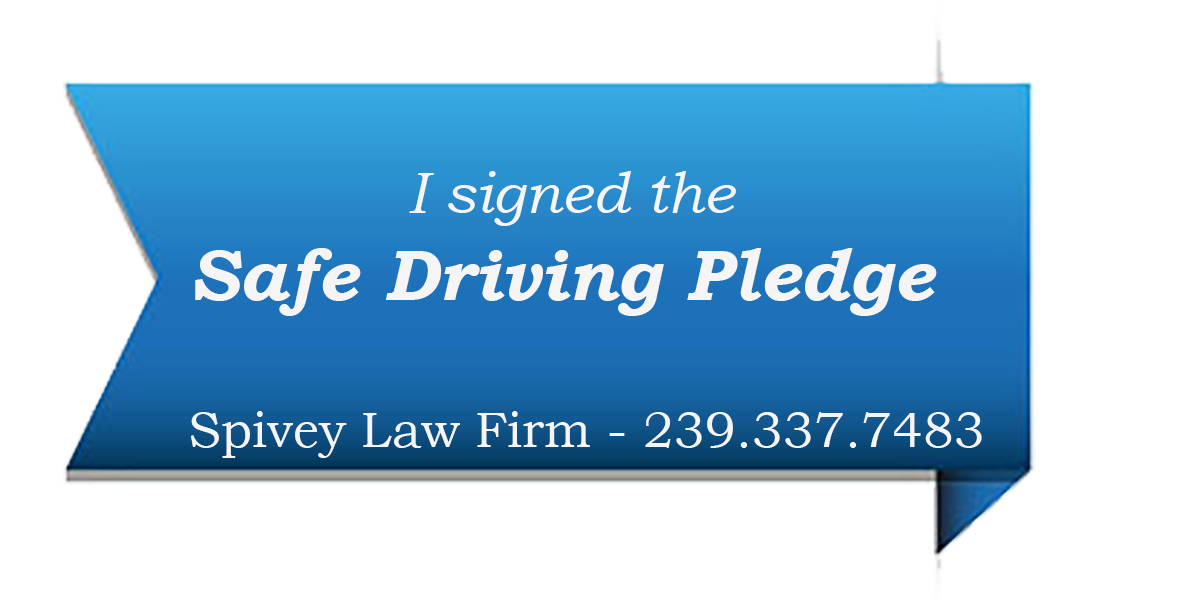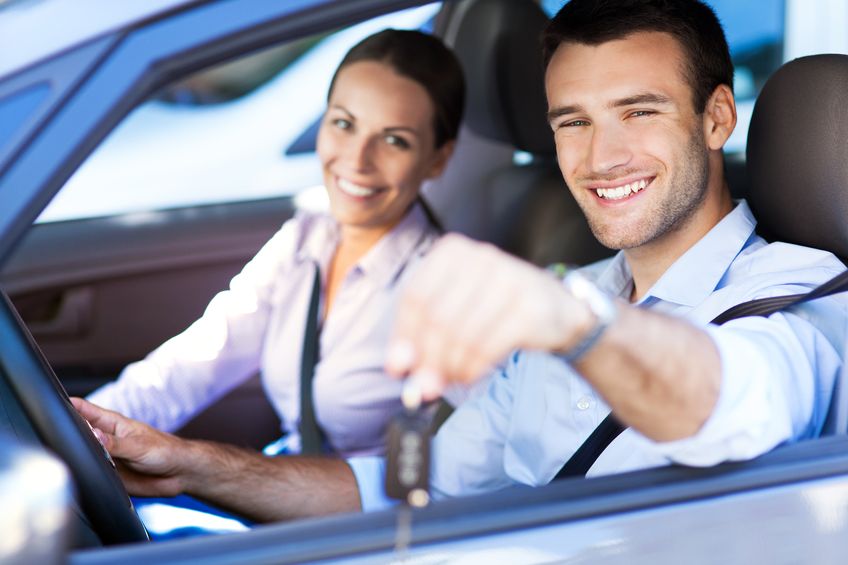Be a Safe Driver – Take the “Safe Driving Pledge”
October 11, 2018 | Category: Automobile Accidents, Firm News | ShareThe relationship between driving behavior and traffic accidents has long been studied. A report done by the National Research Institute of Police Science used data recorders to monitor driving behaviors. The research showed there is a relationship between driving behavior and traffic accidents: “A driver’s awareness of the traffic situation is closely associated with the occurrence of traffic accidents.”
 “Traffic accidents injure and kill thousands of people every year in the United States. Many of these accidents can be avoided if drivers would adopt behavioral changes. In an effort to assist drivers in making these changes, I created a Safe Driving Pledge. In creating this pledge, I wanted to be sure it was applicable to drivers of all ages. With my decades of experience in representing people and their families injured or killed in traffic crashes, I based the Safe Driving Pledge on the most common ways accidents happen and the best ways to prevent them. Please regularly review this pledge and keep it as a handy reference.”
“Traffic accidents injure and kill thousands of people every year in the United States. Many of these accidents can be avoided if drivers would adopt behavioral changes. In an effort to assist drivers in making these changes, I created a Safe Driving Pledge. In creating this pledge, I wanted to be sure it was applicable to drivers of all ages. With my decades of experience in representing people and their families injured or killed in traffic crashes, I based the Safe Driving Pledge on the most common ways accidents happen and the best ways to prevent them. Please regularly review this pledge and keep it as a handy reference.”
The Safe Driving Pledge is below and may be accessed for download on the firm’s website: Safe Driving Pledge.
Safe Driving Pledge

- I will always wear a seatbelt. I will make sure every passenger in my vehicle wears a seatbelt.
- I will never talk on a cell phone or text while operating a motor vehicle, even when stopped at a red light or stop sign.
- Most common accidents: 1) rear-ending another vehicle; 2) turning left into the path of an oncoming vehicle.
- I will never follow another vehicle too closely. I will always maintain a safe following distance. Rear-end accidents are the most common type of accident. Taking my eyes off the road ahead can cause me to rear-end another vehicle. I will allow at least 10 car lengths and 6 seconds of space between me and the car I am following, even more on interstates or roads with higher speed limits.
- I will not be distracted while driving. Distractions include cell phone use, eating, drinking, music, changing the radio station, talking to friends, or looking over at a passenger causing me to take my eyes off the road.
- I will always obey speed limits. I will never engage in street racing, or road rage. I will never get into a car with a driver who may engage in street racing.
- I will never drink alcohol and drive (not even a single drink). I will never drive after taking drugs or prescription medicine that causes me to be t Alcohol and drugs severely impair reaction time, and the ability to judge the speed or distance of an oncoming car. Operating a vehicle while impaired is a crime, and people get arrested for it. I will not allow anyone to have drugs or alcohol inside my vehicle. Possession of alcohol or drugs by people under age 21, inside my car, could get me arrested, since I am the operator in control of the vehicle.
- I will never get into a vehicle if the driver has been drinking or using drugs. I will not let someone I know drive after drinking alcohol or taking drugs. I will call a cab instead or use a designated driver. People go to jail, get injured or killed, and cause injury and death to innocent people every day from drinking and driving. This could have been prevented if they used a designated driver or called a cab.
- Don't get in a car with people you don't know and trust.
- I will call someone I know, or a cab, for a ride home if I have been drinking or using drugs, or if I need a ride home.
- Look at least twice before turning or pulling out from a stop sign or at an intersection. An oncoming vehicle can easily block your view of another vehicle that is coming behind it.
- Always take the safer alternative, even if doing so takes more time. For example, do not try to turn across busy intersections or entrances to stores of shopping There are always safer alternatives. Go to a different entrance that may have a stop light or safer access to where you are going, or simply go further down the road to a controlled intersection where you can make a legal U-turn and come back to your destination.
- Intersections are deadly and I will always scan for other vehicles as I approach an intersection, even if I have a green light or the right of way. I will always reduce my speed when approaching an intersection. I will expect the unexpected. I will not assume the other vehicles, who have a stop sign or red light, will stop. Vehicles approaching from my right or left may not stop for a red light or stop sign and could run into me at full speed, causing me to roll over. I will scan the environment at all times.
- I will use extreme caution when pedestrians, bikes, or kids are around. Expect the unexpected. When I see bikes, people walking, or kids playing, I will reduce my speed and my foot will be on the brake pedal as I pass them. They may walk, or run, out into the road in front of me.
- Never change lanes unless you have checked all mirrors at least Before changing lanes, look over your shoulder behind you so you can see past the blind spot. Make sure to use your turn signal before changing lanes.
- Use extreme caution around motorcycles. Check twice and save a life. Motorcycles are everywhere. Motorcycles are harder to see due to their size. Do not turn if you do not have a clear view of what might be approaching. Wait to turn until you have a clear view of oncoming traffic. It is more difficult to judge the speed of an oncoming motorcycle due to its size. Do not turn left into the path of an oncoming motorcycle. Allow the motorcycle to pass before you turn. Numerous motorcyclists are injured or killed each year because drivers turn left in front of the oncoming motorcycle. You can save a life by following these rules.
- The waiving driver will get you and your passengers hurt or Numerous accidents occur because drivers try to turn across multiple lanes of traffic, and they see cars stopped in most lanes, but there is one lane still open that you cannot see. A driver of a stopped car may waive or signal to you that it is okay to turn. DO NOT TURN. You cannot see what is coming in the open lane. Those cars are often travelling at full speed.
- Wet roads are dangerous. Reduce speed on wet roads. Water can cause your vehicle to hydroplane and lose control.
- Fog is very dangerous. Do not drive in fog. If you encounter fog, reduce your speed a lot and go slow. Cars ahead of you may crash, and you could crash into them; then, other vehicles behind you will crash into you.
- Never jerk the Never over-correct. If your vehicle goes off the road for any reason, never jerk the wheel to get back onto the road. Simply apply your brakes, slow down, then, come back onto the road slowly. Roll-over crashes are caused by drivers over-correcting or jerking the wheel when drivers leave the roadway or encounter debris in the roadway. It is better to hit the debris than to roll the vehicle over.
- I am required to report any accident I am involved in and remain at the scene. Leaving the scene of an accident is a crime.
- If involved in an accident, do not stand in the road. Other cars could hit you. If the car is drivable, pull out of the roadway and wait for police. If the car is not drivable, walk to a safe area off of the roadway and far enough off the road that another car will not hit you. Do not stand in the road.
- Do not drive next to big trucks or tractor trailers. Big trucks can swerve into your lane or change lanes into you, causing horrible Do not stay in front of a big truck or tractor trailer. If a big truck rear-ends you, it can cause serious injury or death due to its size and weight. Get out of the way and let the truck pass you. Do not stay in front of it or beside it.
- I will regularly (at least once per month) check the air in my tires. I will inflate the tires to the pressure called for by the manufacturer (usually the inflation information is located inside the door jam or gas cap cover). Tires that are low on air or over-inflated can blow out, causing me to lose control.
- I will not drive on bald tires. Replace tires when they show signs of too much wear. Bald or worn-out tires cause cars to lose control, especially when the roads are wet.
- Always drive with your headlights on.
I, ____________________________________, hereby agree that I will follow these safe driving tips at all times to keep myself, my passengers, and all motorists on the roadways safe.
Date: _________
x _
Fort Myers Personal Injury Attorney, Randall L. Spivey is a Board Certified Trial Attorney – the highest recognition for competence bestowed by the Florida Bar and a distinction earned by just one (1%) percent of Florida attorneys. He has handled over 2,000 personal injury and wrongful death cases throughout Florida. For a free and confidential consultation to discuss your legal rights, contact the Spivey Law Firm, Personal Injury Attorneys, P.A., in Lee County at 239.337.7483 or toll free at 1.888.477.4839, or by email to Randall@SpiveyLaw.com. Visit SpiveyLaw.com for more information. You can contact Spivey Law Firm, Personal Injury Attorneys, P.A.in Charlotte County at 941.764.7748 and in Collier County 239.793.7748.

